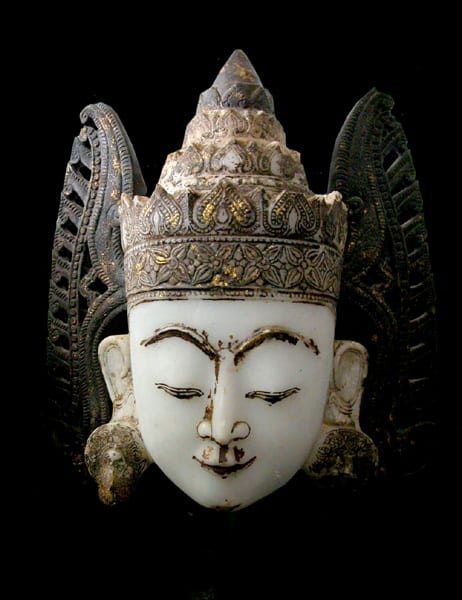Shan Marble Head of the King of the Buddhas, 17th Century CE - 18th Century CE
Marble
20.5
X.0221
The Shan people are a distinct ethnic group that today constitute Myanmar’s largest minority group. However, from the 13th until the 16th Century, they dominated most of the country. They...
The Shan people are a distinct ethnic group that today constitute Myanmar’s largest minority group. However, from the 13th until the 16th Century, they dominated most of the country. They are largely Buddhist, and their language and customs are closely related to the Thai and Laotians their neighbors to the south and east. In the 19th Century, long after their power had eroded, they were distributed among thirty petty states that paid tribute first to the Burman King, then to the British. This arrangement remained more or less in tact until 1922 when the Federated Shan States were joined together. In 1947, a unified Shan States was created under the Burmese Constitution. Although much of their autonomy has been relinquished to the central government, the Shan retain their unique cultural identity and ethnic heritage.
This magnificent marble head of the Buddha dates from the declining days of the Shan Period. Although the Buddha only dressed in monastic robes, here he is shown as the King of the Buddha, or the ruler of the universe. Iconographically, it bears much in common with a type known as the Subduer of Jambhupati. Specifically, the elaborate headdress with a conical peak that resembles a pagoda and two wing-like flanges is characteristic of both these types. Such images of the Buddha are specifically unique to Myanmar, where bejeweled, crowned representations of Bodhisattvas were not common as in other Buddhist countries. Thus, the Buddha, who abandoned his royal upbringing in order to seek the path of enlightenment, can now be seen as a King, not of earth, but of the heavens.
This magnificent marble head of the Buddha dates from the declining days of the Shan Period. Although the Buddha only dressed in monastic robes, here he is shown as the King of the Buddha, or the ruler of the universe. Iconographically, it bears much in common with a type known as the Subduer of Jambhupati. Specifically, the elaborate headdress with a conical peak that resembles a pagoda and two wing-like flanges is characteristic of both these types. Such images of the Buddha are specifically unique to Myanmar, where bejeweled, crowned representations of Bodhisattvas were not common as in other Buddhist countries. Thus, the Buddha, who abandoned his royal upbringing in order to seek the path of enlightenment, can now be seen as a King, not of earth, but of the heavens.



